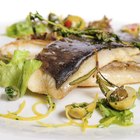The great blue heron, sometimes referred to as the blue crane, is a predatory bird that frequents shallow ponds to catch fish and frogs. In the process, it can transport algae, diseases and even fish eggs to other bodies of water. While this bird can become a nuisance, it is a protected species, so extermination is not an option. There are other methods, however, to keep cranes out of fish ponds.
Place leaf netting over your pond. Secure the netting by attaching it to stakes installed in the ground around the pond. This will keep leaves out of your pond during the fall and prevent cranes from eating your fish. Choose netting with mesh small enough to keep leaves from falling through it. When winter arrives, remove the netting.
Purchase a motion-activated sprinkler such as the Scarecrow. This sprinkler is mounted on a stake that you can install in the ground near your pond; you can also use a mounting bracket to attach it to a fence. The sprinkler has a motion detector that will be triggered when a crane or another predator approaches. The visitor will be sprayed with water for approximately 3 seconds each time it approaches. One Scarecrow sprinkler will cover approximately 1,200 square feet.
Place a statue of a blue heron near the edge of the pond or in the water. Sometimes the decoy will deter other herons from approaching. You will need to move the statue around so that it will appear to be real. Blue herons are not fooled easily. You can also float a fake alligator in the water. Alligators eat birds; the presence of a fake one may keep cranes from using your fish pond as a food source.
Install dense plant life or a fence around the pond to prevent cranes from walking up to the edge of the water to wade.
Related Articles

Are Farm Raised Mussels & Clams Healthy ...
Fun Things to Do in Oregon With Kids
Free Things to Do in Oklahoma City

How to Keep Mosquitoes Away When ...

How to Kill Mice in a Chicken Coop

Types of Crabs in the Atlantic Ocean
Free Things to Do in Portland
How Do I Clean Water Cress?

How to Cook Grunion

The Best Snorkeling Along the Florida ...

How to Cook Permit Fish

Alternate Ways to Divert Roof Rain Water
Free Things to Do in the Quad Cities

When Is King Crab Season?
5 North Carolina Family Vacation Ideas

Fun Things to Do for a Teen Birthday ...

How to Use a Wash Basin
Free Things to Do in Colorado Springs

Benefits of Lotus Stem
Things to Do in Okinawa
Tips
- If you are digging a fish pond, dig at least 1/3 of the pond floor deeper than 3 feet. A crane will not be able to wade in water this deep.
Warnings
- Once a crane comes to your pond and is successful catching and eating fish, it will return repeatedly until all of the fish are gone.
Writer Bio
Based in Texas, Cynthia Measom has been writing various parenting, business and finance and education articles since 2011. Her articles have appeared on websites such as The Bump and Motley Fool. Measom received a Bachelor of Arts in English from the University of Texas at Austin.